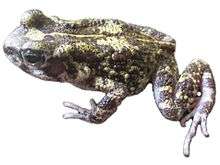Amietophrynus perreti
| Amietophrynus perreti | |
|---|---|
 | |
| Scientific classification | |
| Kingdom: | Animalia |
| Phylum: | Chordata |
| Class: | Amphibia |
| Order: | Anura |
| Family: | Bufonidae |
| Genus: | Amietophrynus |
| Species: | A. perreti |
| Binomial name | |
| Amietophrynus perreti (Schiøtz, 1963) | |
| Synonyms | |
|
Bufo perreti Schiøtz, 1963 | |
Amietophrynus perreti, or the Perret's toad, is a species of toad in the family Bufonidae. It is endemic to the Idanre Hill in southwestern Nigeria.[2][3] The specific name honors Jean-Luc Perret, a Swiss herpetologist.[3] Its natural habitats are subtropical or tropical moist lowland forests, subtropical or tropical moist shrubland, and rocky areas.
Amietophrynus perreti is one the frogs declared as "Lost" in 2010.[4] However, it was re-discovered at its type locality in 2013. Before that, it had not been seen—possibly—since 1970, and with certainty, since 1963.[3]
Etymology
The specific name perreti honours Jean-Luc Perret, a Swiss herpetologist who has spezialized in African amphibians.[5]
Description
Males measure 39–40 mm (1.5–1.6 in) and females 55–64 mm (2.2–2.5 in) in snout–vent length. The head is comparatively flat. Males have white throats. Parotoid glands are moderately developed.[3]
The adult frogs live in patches of shrubby vegetation occurring on the inselbergs or gneiss domes in the forest on which it lives.[1] Tadpoles are unusual compared to other Amietophrynus species: they are not aquatic but semi-terrestrial, living in shallow water-films on wet, sometimes nearly vertical rocks.[3]

Habitat and conservation
Perret's toad is endemic to Nigeria where it is known from a single locality, the Idanre Hill in the southwestern part of the country. Only one population of Amietophrynus perreti is known. Searches in nearby areas have failed to locate other populations in suitable habitat,[3] nevertheless, the toad is common in the location where it is found and the tadpoles plentiful. The area is rocky and inaccessible and the International Union for Conservation of Nature thinks it likely that more populations would be found if more herpetological surveys were done; no particular threats have been recognised and the frog is considered to be a "vulnerable species" because of its small known range.[1]
References
- 1 2 3 Schiøtz, A. & Tandy, M. 2004. Bufo perreti. 2006 IUCN Red List of Threatened Species. Archived June 27, 2014, at the Wayback Machine. Downloaded on 21 July 2007
- ↑ Frost, Darrel R. (2015). "Amietophrynus perreti (Schiøtz, 1963)". Amphibian Species of the World: an Online Reference. Version 6.0. American Museum of Natural History. Retrieved 24 October 2015.
- 1 2 3 4 5 6 Onadeko, Abiodun B.; Rödel, Mark-Oliver; Liedtke, H. Christoph; Barej, Michael (2014). "The rediscovery of Perret's toad, Amietophrynus perreti (Schiøtz, 1963) after more than 40 years, with comments on the species' phylogenetic placement and conservation status". Zoosystematics and Evolution. 90 (2): 113–119. doi:10.3897/zse.90.8234.
- ↑ "The Search for Lost Frogs". amphibians.org. Amphibian Specialist Group (ASG) and Amphibian Survival Alliance (ASA). 2014. Retrieved 24 October 2015.
- ↑ Bo Beolens; Michael Watkins; Michael Grayson (22 April 2013). The Eponym Dictionary of Amphibians. Pelagic Publishing. p. 166. ISBN 978-1-907807-44-2.
